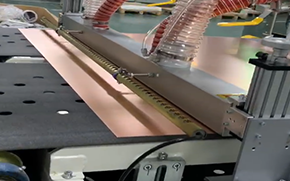Understanding the Role of a Multifunctional Tension Controller in Modern Sensors: Enhancing Accuracy and Efficiency
Date:
2025-04-01
Understanding the Role of a Multifunctional Tension Controller in Modern Sensors
Table of Contents
1. Introduction to Multifunctional Tension Controllers
2. The Importance of Tension Control in Sensors
3. How Multifunctional Tension Controllers Work
3.1 Key Components of a Tension Controller
3.2 Mechanisms of Tension Adjustment
4. Applications of Multifunctional Tension Controllers in Modern Sensors
4.1 Industrial Automation
4.2 Robotics
4.3 Medical Devices
5. Benefits of Implementing Tension Controllers in Sensor Systems
5.1 Enhanced Precision and Accuracy
5.2 Increased Operational Efficiency
6. Challenges and Considerations in Tension Control
6.1 Calibration and Maintenance
6.2 Integration with Existing Systems
7. Future Trends in Multifunctional Tension Controllers
8. Conclusion
9. Frequently Asked Questions (FAQs)
1. Introduction to Multifunctional Tension Controllers
In the ever-evolving world of technology, **multifunctional tension controllers** play a pivotal role in enhancing the performance of **modern sensors**. These sophisticated devices are engineered to maintain and regulate tension in various applications, ensuring that sensors operate optimally. As industries increasingly rely on precise measurements, understanding the functionality and significance of these controllers becomes essential.
2. The Importance of Tension Control in Sensors
Tension control is crucial in sensor applications due to its direct impact on accuracy and reliability. In many sensor systems, particularly those involved in measuring physical properties like pressure, force, and displacement, maintaining the right amount of tension is vital. An improper tension can lead to inaccurate readings, operational failures, and even damage to equipment.
3. How Multifunctional Tension Controllers Work
Multifunctional tension controllers employ advanced technologies to monitor and adjust tension levels in real-time. By utilizing feedback mechanisms, they ensure that the tension remains within specified limits, optimizing sensor performance.
3.1 Key Components of a Tension Controller
A typical multifunctional tension controller comprises several key components, including:
- **Sensors**: Detect the current tension levels.
- **Actuators**: Adjust tension based on sensor feedback.
- **Control Algorithms**: Process data to maintain optimal tension levels.
- **User Interface**: Allows operators to monitor and configure settings.
3.2 Mechanisms of Tension Adjustment
Tension adjustment can be achieved through various mechanisms, including:
- **Mechanical Adjustments**: Utilizing gears or levers to change tension manually.
- **Electronic Control**: Using motors and digital feedback loops to automate adjustments.
- **Hydraulic Systems**: Employing fluid pressure to create tension dynamically.
4. Applications of Multifunctional Tension Controllers in Modern Sensors
Multifunctional tension controllers find extensive use across various industries, enhancing the performance of sensors in multiple applications.
4.1 Industrial Automation
In industrial settings, tension controllers are used in automated assembly lines to ensure that sensors monitoring product quality operate efficiently. Maintaining consistent tension allows for accurate measurements, improving the overall quality of production.
4.2 Robotics
Robots equipped with tension-controlled sensors can perform tasks requiring precision, such as surgical procedures or delicate assembly. The ability to maintain optimal tension ensures that sensors provide accurate feedback, crucial for responsive robotic movements.
4.3 Medical Devices
In medical applications, tension control is vital for devices such as blood pressure monitors and diagnostic equipment. Accurate tension levels enhance the reliability of readings, which is critical for patient safety and effective medical interventions.
5. Benefits of Implementing Tension Controllers in Sensor Systems
Integrating multifunctional tension controllers into sensor systems yields numerous benefits.
5.1 Enhanced Precision and Accuracy
With precise tension control, sensors can deliver more accurate readings. This accuracy is pivotal in applications ranging from industrial processes to medical diagnostics, where even minor discrepancies can lead to significant consequences.
5.2 Increased Operational Efficiency
By ensuring that sensors operate within optimal tension ranges, organizations can enhance their overall operational efficiency. Fewer errors lead to reduced downtime, lower maintenance costs, and improved output quality.
6. Challenges and Considerations in Tension Control
While multifunctional tension controllers offer numerous advantages, several challenges must be addressed.
6.1 Calibration and Maintenance
Regular calibration is essential to ensure that tension controllers function correctly. Over time, components may wear out or drift from their calibrated settings, leading to decreased accuracy. Establishing a maintenance schedule can mitigate these issues.
6.2 Integration with Existing Systems
Integrating tension controllers into existing systems can pose challenges, particularly in older machinery. Compatibility issues may arise, necessitating updates or modifications to ensure seamless operation.
7. Future Trends in Multifunctional Tension Controllers
As technology evolves, so too will the capabilities of multifunctional tension controllers. Emerging trends include:
- **Smart Technologies**: Incorporating IoT capabilities for remote monitoring and control.
- **Advanced Materials**: Utilizing lightweight, durable materials to enhance performance.
- **AI Integration**: Leveraging artificial intelligence to optimize tension control processes.
8. Conclusion
In conclusion, multifunctional tension controllers play a significant role in enhancing sensor performance across various applications. Their ability to maintain optimal tension levels leads to improved accuracy, efficiency, and reliability. As industries continue to advance, the importance of these controllers will only grow, paving the way for innovations that can revolutionize how sensors operate.
9. Frequently Asked Questions (FAQs)
Q1: What is a multifunctional tension controller?
A multifunctional tension controller is a device designed to maintain and regulate the tension in various applications, ensuring optimal sensor performance.
Q2: How do tension controllers improve sensor accuracy?
By maintaining proper tension levels, tension controllers help ensure that sensors provide precise measurements, thereby enhancing accuracy.
Q3: In which industries are multifunctional tension controllers commonly used?
These controllers are widely used in industrial automation, robotics, and medical devices, among other applications.
Q4: What are the main components of a tension controller?
Key components include sensors, actuators, control algorithms, and user interfaces, all working together to maintain optimal tension.
Q5: What future trends can we expect in tension controllers?
Emerging trends include the integration of smart technologies, advanced materials, and AI to optimize tension control processes.
This comprehensive exploration of multifunctional tension controllers highlights their vital role in modern sensor technology, ensuring that industries can rely on accurate and efficient measurements to drive innovation and success.
Related information
2025-05-21
2025-05-21









